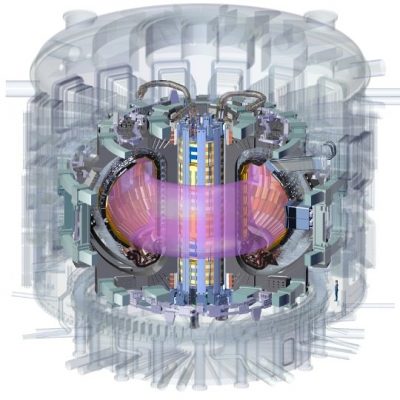A long time ago in a galaxy far, far away, an epic sci fi space-opera was created by George Lucas, which became a worldwide pop-culture phenomenon. But how much real science lurks in the fictional worlds of Star Wars?
As we prepare our blockbuster immersive exhibition, Science Fiction: Voyage To The Edge Of Imagination, I talked to Federico Felici of the EPFL, the Swiss Federal Institute of Technology in Lausanne, about the lightsaber, the weapon of choice for the Jedi, along with the Sith, their sworn enemies.
Lightsabers, glowing ‘laser swords’, are thought by many to tame what is called the fourth state of matter (after solid, liquid and gas), so called plasma – matter that is so hot that its component atoms fall apart to form a soup of positively charged particles (ions) and negatively charged particles (electrons).
Felici is ideally placed to comment on lightsabers, having co-authored a recent Nature paper with the UK AI company DeepMind on how to sculpt and control plasma for nuclear fusion reactors.
In the case of the giant ITER fusion reactor under construction in France the plasma will reach 150 million °C—or ten times the temperature at the core of our Sun—as part of a quest to tap fusion’s potential for a near limitless low-carbon source of energy.

No Earthly material can withstand plasma at these temperatures, and it must be held away from the walls of the reactor by extraordinarily powerful magnetic fields.
The resulting ‘magnetic bottle’ used to confine the plasma in ITER, and many other fusion reactors is called a tokamak, a doughnut-shaped vacuum chamber surrounded by magnetic coils.
Magnetic fields are the key to containing the plasma in a lightsaber too, speculates Felici, though he adds that a plasma capable of cutting through steel would not have to be anything like as hot as that required for nuclear fusion, merely a few thousand degrees.
An insulating handle would enable a Jedi to safely wield this weapon without anything elaborate, such as the ‘thermal cloaks’ now under development using ‘metamaterials’ or heat pumps.
Varying plasma temperatures also account for the different lightsaber colours, from blue and green to red and purple, going from red for lower temperatures and blue for higher (though it is possible the colours might also reflect chemical impurities in the plasma, he adds).
Confining a plasma into a cylinder-like shape is not straightforward due to what is called the ‘hairy ball theorem’, says Felici: imagine a ball covered in long hairs (which are equivalent to the magnetic field lines). If one were to try to comb those hairs down, there will always be at least one spot where the hairs will not lie flat. ‘One of the hairs will always stand up and there is no way to confine the plasma.’
To wrap the plasma in magnetic fields effectively, the answer is to use the same approach as in nuclear fusion and harness the toroidal shape of a tokamak. Felici believes the plasma in a lightsaber may look cylindrical to the naked eye but in fact consists of an elongated doughnut shape, with a narrow cavity at its core. “From a topological point of view, this would be the same as a tokamak and overcome the hairy ball problem,” he says.
Keeping the plasma in the right shape (what physicists call ‘confinement’) is also difficult because plasma is inherently unstable. The curator of the Science Fiction exhibition, Glyn Morgan, comments: “this could perhaps be the reason behind the instability we see in the lightsaber of character Kylo Ren which spits and hisses in contrast to the smooth solidity of others.”
A conventional control system for a fusion reactor has to coordinate and alter the voltages of many magnetic coils thousands of times per second to ensure the plasma never touches the walls of the vessel, which would result in heat loss, quench the fusion reaction and possibly cause damage.
To improve the way plasma is confined, the EPFL/DeepMind team recently developed the first ‘deep reinforcement learning system’ to autonomously discover how to control these coils and successfully contain the plasma in a tokamak, allowing it to vary virtual magnetic fields in a virtual fusion reactor to find the right combinations to lock the plasma into the right shape.
“In our paper published in the journal Nature, we describe how we can successfully control nuclear fusion plasma by building and running controllers on the Variable Configuration Tokamak (TCV) in Lausanne, Switzerland” he said.
Unlike the separate algorithm-based controllers used for each of the 19 magnetic coils in the Swiss tokamak, DeepMind AI carries out deep reinforcement learning with a single AI—one loosely modelled on the brain called a neural network—to control all the coils at once.
“We produced AI controllers that can both keep the plasma steady and be used to accurately sculpt it into different shapes”, he said. One simulation shows a doughnut shaped plasma moving up and down inside the Swiss tokamak, while others show how AI could sculpt the plasma cross section into various shapes, from a snowflake to two plasma rings, each with a droplet-shaped cross sections.
In a similar way, Felici concludes, electromagnetic fields generated by the handle of the lightsaber keep its plasma in check (though he added that it is also possible that the lightsaber might use what is called a ‘levitated dipole’, which relies on a free floating magnet and has been tested in America).
Some have built a glorified plasma blowtorch to create an impressive looking retractable lightsaber but, says Felici, the characteristic drone and hum of a lightsaber are highly suggestive of the noise made as a result of electromagnetic fields. “When you are moving a strong magnetic field like this through space, ionisation occurs the atmosphere and that might make the characteristic noise,” he adds.
There is, however, one last technical challenge to overcome, when lightsabers clash in a battle. Then the confining magnetic fields of each lightsaber will interact and combine into a new magnetic configuration – releasing huge amounts of energy from the plasma in each lightsaber. This process is known as magnetic reconnection.
For Felici, the reason these explosive reconnections do not occur, and only a ‘clash, clash, clash’ is heard during lightsaber duels, is obvious: the answer is something to do with that familiar feature of Jedi and Sith life known as ‘The Force.’
As for the nature of ‘The Force’ that prevents these explosive reconnections, ITER magnet engineer Enrique Gaxiola speculates that it is none other than the Lorentz force, which is responsible for many fascinating phenomena, such as the shimmering Northern Lights that occur when charged particles from the Sun rain down on Earth.
“When charged particles in a plasma pass through a magnetic field they feel a Lorentz force due to their electric charge, so if the lightsabers have opposite currents – and it seems likely the Jedi have positive polarity and Sith negative – this force is repulsive, as we clearly saw in the duels of our young Jedi hero with his father, Darth Vader.“
He adds: “Lightsaber physics is well worth studying because scientists are trying to come up with a unified theory of the four fundamental forces of nature – gravitational, weak nuclear, electromagnetic and strong nuclear forces – and the way that a lightsaber unites forces and light is very relevant to the quest for a grand unified field theory.”
Science Fiction: Voyage to the Edge of Imagination is open at the Science Museum until 20 August 2023. Book your tickets now
